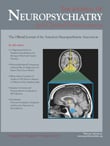Amisulpride May Worsen Dyskinesia and Trigger New-Onset Dyskinetic Movements
To the Editor: There is surprisingly little literature on tardive dyskinesia with amisulpride. A PubMed search conducted on March 19, 2009, identified only three relevant case reports. 1 – 3 We report a patient whose existing tardive dyskinesia worsened and who developed new dyskinetic movements after treatment with amisulpride. We discuss distinct mechanisms whereby amisulpride may be associated with tardive dyskinesia.
Case Report
Mrs. A, a 72-year-old woman with DSM-IV schizophrenia, presented with a 3-year history of dyskinetic movements of the right forearm, wrist, and fingers. She had received trifluperazine, haloperidol, risperidone, and other antipsychotics in the past and had been receiving chlorpromazine, 300 mg/day, during the 3 years prior to the index presentation. Her Abnormal Involuntary Movement Scale (AIMS) score was 5. Her medical comorbidity included diabetes mellitus and hypertension, both of which were well controlled. There was no past or current history of substance use or neurological disorder, nor any family history of movement disorders. In order to address the dyskinesia, the dose of chlorpromazine was reduced to 100 mg/day. Two months later, whereas the tardive dyskinesia persisted and remained unchanged, positive symptoms of psychosis emerged.
Amisulpride (350 mg/day) was added to the 100 mg/day of chlorpromazine. This resulted in moderate improvement in psychiatric symptomatology but, after about 10–12 weeks of combined therapy, the existing dyskinesia was noted to have worsened, and new choreoathetoid movements appeared in the buccal, jaw, and tongue areas, and in the left forearm, wrist, and fingers. Akathisia was also present. Her AIMS score was 14. Chlorpromazine was withdrawn. She was maintained with amisulpride, 350 mg/day, alone; however, 6 weeks later, there was no improvement in the dyskinetic movements. She was later lost to follow-up.
Discussion
Risk factors for tardive dyskinesia in our patient were old age, female gender, diabetes mellitus, and exposure to neuroleptic and other antipsychotic drugs. 4 Tardive dyskinesia in our patient had appeared during treatment with chlorpromazine and had persisted unchanged until amisulpride was introduced. The introduction of amisulpride was associated with worsening of the original tardive dyskinesia and development of new-onset tardive dyskinesia. Lowering of the chlorpromazine dose could have unmasked tardive dyskinesia in the oral regions and in the left hand, or the addition of amisulpride could have triggered the new-onset tardive dyskinesia. We favor the latter explanation because unmasking of tardive dyskinesia should have occurred shortly after the decrease in chlorpromazine dose; however, the new-onset tardive dyskinesia actually appeared after 3 months of combined therapy, implying a gradual-onset consequence of the amisulpride-chlorpromazine combination. All previous cases reported the development of tardive dyskinesia 8–24 months after the patients were started on amisulpride.
Why was amisulpride associated with new-onset tardive dyskinesia? The dose of 350 mg/day appeared to be optimal to treat psychosis in this geriatric patient, 5 presumably by blocking dopamine postsynaptic receptors in the mesolimbic pathway; however, it is conceivable that it may not have been sufficiently high to block dopamine postsynaptic receptors in the nigrostriatal pathway, due to which the increased presynaptic release of dopamine may have increased postsynaptic dopaminergic neurotransmission in neurons already sensitized by prior exposure to neuroleptic drugs. This would have led to the emergence of new tardive dyskinesia and worsening of existing dyskinesia.
1. Fountoulakis KN, Panagiotidis P, Siamouli M, et al: Amisulpride-induced tardive dyskinesia. Schizophr Res 2006; 88:232–234Google Scholar
2. Masdrakis VG, Papadimitriou GN, Papageorgiou C, et al: Development of tardive dyskinesia in a patient taking amisulpride. Prog Neuropsychopharmacol Biol Psychiatry 2007; 31:586–587Google Scholar
3. Sevincok L, Balci V, Akyildiz U: Tardive dystonia associated with low dose of amisulpride: a case report. J Clin Psychopharmacol 2008; 28:573–574Google Scholar
4. Gerlach J, Casey DE: Tardive dyskinesia. Acta Psychiatr Scand 1988; 77:369–378Google Scholar
5. Riedel M, Eich FX, Möller HJ: A pilot study of the safety and efficacy of amisulpride and risperidone in elderly psychotic patients. Eur Psychiatry 2009; 24:149–153Google Scholar



